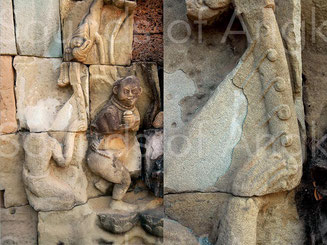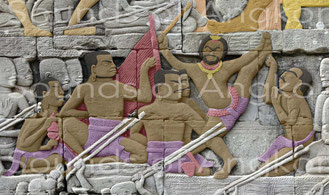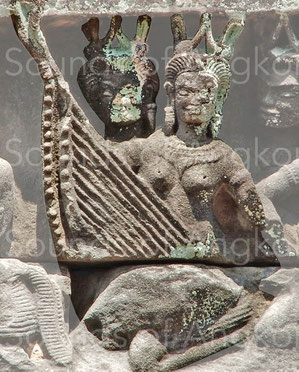
Angkorian harp
The Khmer harp, originating from India, spread throughout Southeast Asia with the expansion of Hinduism and Buddhism. Its journey can be traced in India, Afghanistan, Myanmar, China, Cambodia, Laos, and Vietnam. With an arched or boat-shaped form, it resembles the Burmese saung-gauk. Present in Cambodia during the pre-Angkorian and Angkorian periods, it disappears from records after the early 13th century. Its name, derived from the Sanskrit vīṇā, became pin in modern Khmer, designating various stringed instruments. The memory of the harp persists, as evidenced by a musician from Battambang in the 1960s, who mentioned an instrument with 21 strings, a number confirmed by bas-reliefs at the Bayon temple. Despite its disappearance, the image of the Khmer harp was preserved in some Buddhist monasteries in Cambodia in the mid-20th century.
Last update: October 30, 2024
Representations of Angkorian harps are found in Angkor Wat, Bayon, Banteay Chhmar, Banteay Samre,
Elephant Terrace, Preah Pithu
and Western Mebon.
The shape of the instruments differs according to the sculptors. There is no standard. All the harps, however, have in common a boat-shaped sound
box and a handle more or less arched. The strings and the tuning system are sometimes represented. The head above the handle is a variable
element.
During the reign of King Jayavarman VII, late 12th-early 13th centuries the harp, accompanied by other instruments, animated the dance at the royal palace and in the temples, and also accompanied the entertainment.

Tuning system
A sculptural detail of this harp gives us a precise knowledge of the
tuning system in the 13th century (1). This
high relief is damaged but the residual sculpture shows the essential: a peg tuning system. The end of the axle around which the rope is wound and the winding
direction of the string. The pegs are on the left side for right-handed harpists, the
majority case.
Another harp from the
Elephant Terrace and some others at Bayon temple, with less precision, seem to have the same type of tuning.
Some ancient harps of India were tuned with a braided necklace sliding along the neck. In the case of the Burmese saùng-gauk, it is a stringent stringing system nowadays increasingly supplanted by guitar mechanics. A Bayon harp shows this tuning mode. We clearly see links around the neck (3).
How many strings?
How many strings did the harps have? Although they are often depicted, it is difficult to draw any conclusion as to their number. Sometimes it can be considered that the sculptor represented them in large numbers without reference to reality. In other cases, the artist seems to have applied himself to sculpting them accurately. The best representations show a maximum of eleven or twenty-one strings. There are also some representations with seven or fourteen strings. The number seven reflects the exact scalar system and fourteen, its repetition.
In classical India, the number of strings varied, depending on the period, from seven to fourteen.

We photographed this harp in the dark in low light. This bas-relief of the eastern interior gallery of the Bayon did not inspire confidence a priori given its condition and the lack of care taken to certain details. However, a closer look reveals that the strings and their attachment to the neck received the greatest attention. We can almost affirm that the instrument has twenty-one strings and that the angle of the string plane, given this number, is consistent. A recent reconstruction of this instrument by Sounds of Angkor attests to this.
Symbolism of the number of strings/notes
The monochord zither kinnara, with its harmonic playing technique, is a constrained instrument by nature. Indeed, the number of notes it can emit is limited and cannot be increased by any process; this is inherent to the physical functioning of the string. On the contrary, zithers or lutes with frets can emit a greater number of notes as soon as their length and the number of frets are increased. The kinnara can produce a sound with a pitch equal to one twelfth of the fundamental sound, or, in the Khmer scalar system, twelve notes.
According to Khmer symbolism, the number twelve represents the mother. We do not yet know why. In royal ceremonies, a twelve-tiered bay sei is present among the offerings; it represents royalty; the king himself is the "spiritual mother" of the Khmer people.
The harp, for its part, seemed to have twenty-one strings according to a count on two instruments represented in the Bayon bas-reliefs. This number represents the father and the neck of the harp could well represent a stretched phallus!
In several cases, in the Bayon, the harp is represented with eleven strings because the instrument is small and the sculptor made this choice, perhaps for technical reasons related to the friability of the rock to be carved. However, it could be, once again, harps with twenty-one strings with eleven strings represented in positive relief and ten in negative by omission.
It can therefore be seen that the Khmer orchestra, as might be expected, is composed of a female instrument - principal, generator of the melody - and a male instrument - follower, accompaniment of the melody. We believe that this situation existed before the arrival of the Brahmins since the gong ensembles and bamboo instruments of the proto-Khmer people living on the border borders of Cambodia, Laos and Vietnam are structured in this way.
Nature of the strings
No source tells us the nature of the strings. However, if we refer to Burmese ethnology, it is probable that they were made of silk. It is known that the ancient Khmers imported them from China. Moreover, the use of silk allows us to adapt the diameter of each string, like contemporary Burmese harps.
Soundbox
All listed soundboxes are boat-shaped. However, few details appear. If we rely on contemporary instruments such as the Burmese saùng-gauk, it is very likely that they were carved from a single piece of wood and covered with a skin. No decoration is visible. It is also probable but we cannot say for sure that the soundboard and the neck were carved in one and the same piece of wood. We take as an example the piece of wood that is still today at the front of the oxcarts.
Playing position
The harp is played in a sitting or standing position. The musician sometimes holds his instrument with a shoulder strap. On the Banteay Chhmar instrument above, the button for fixing the strap is shown. The musician is mostly placed to the right of his instrument, whether sitting on the ground or standing.
If the right hand played the melody, the left hand probably had a technical role, either accompaniment or play of the bass strings or, as is the case with the Burmese saùng-gauk, of accidental alterations by pressing with the thumb on the string near the handle, or all this at once. On the bas-reliefs, the right hand is sometimes sculpted with great realism. The combination of the best representations of the Angkorian sculpture and the playing technique of the Burmese harp reveals several similarities as below where the index and the middle finger are joint.
The Angkorian harp through the epigraphy
In the ancient Khmer epigraphy, the harp is invariably referred to as vīṇa. However, the word is ambiguous as it refers to a wide range of string instruments in India, especially the stick and tube zither. In India, a prefix or suffix specifies the nature of the vīṇa. In Cambodia, it is necessary to distinguish texts in Sanskrit from those in ancient Khmer. If it is proved that this term designates the harp in ancient Khmer, it must be translated as "zither" in Sanskrit texts.
- The stele of Prasat Komphus (K. 669 - 816 AD) mentions - vīṇa 20 mvāy vluk - 20 harps (including) one in ivory. It also teaches us that the temple received ten harps made of copper alloy and other one of silver.
- The inscriptions of the 9th century of Lolei temple (K. 324S & N, 327S & N, 330S & N, 331S & N) specify the presence of three different harpists for each week of the lunar calendar, divided into light and dark weeks.














